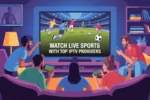In today’s hyper-dynamic marketplace, digital advertising isn’t just evolving — it’s reinventing itself at breakneck speed.
Marketers who cling to yesterday’s strategies will be obsolete tomorrow. The brands that thrive? They’re already adjusting course, aligning with the trends shaping 2025 and beyond.
If you’re still thinking in terms of “Facebook Ads” and “basic SEO,” you’re playing checkers while the market is playing 3D chess.
Let’s break down exactly what’s happening — with real data, real forecasts, and zero sugar-coating.
Disclaimer: We don’t sell IPTV services. We don’t sell apps. We don’t take commissions.
What we actually do? We test, research, compare, and simplify. We dive into forums, scroll through tech blogs, install all kinds of apps (even the weird ones), and package everything into useful shortcuts you can trust.
We’re just a bunch of nerds obsessed with tech, doing our best to save you time and headaches. Everything we write comes from real testing and experience — no fluff, no hype, no bias.
Use it, test it, question it. We’re not here to sell — we’re here to help.
1. First-Party Data Will Become the Lifeblood of Advertising
With Google’s final phase-out of third-party cookies (officially rolling out in mid-2025), advertisers are now forced into a new reality:
Own your audience or pay the price.
-
Brands are rapidly building email lists, SMS databases, and private communities (think Discord, WhatsApp groups) to capture first-party data.
-
Platforms like Facebook and Google are rolling out new ad products specifically geared toward privacy-safe targeting using aggregated data models.
No first-party data = no targeting = no ROAS.
Marketers who still rely heavily on pixel-based retargeting are already feeling the squeeze.
📈 According to HubSpot’s 2025 Marketing Trends Report, 76% of brands are increasing investments in loyalty programs and lead magnets to fuel first-party data acquisition.
2. AI-Driven Ad Creation and Optimization Is Becoming the Norm
Forget about writing individual ads manually for each A/B test.
AI is now building, testing, and optimizing ad variations at scale.
-
Platforms like Meta’s Advantage+ campaigns use machine learning to automatically generate high-converting ads.
-
Google’s Performance Max campaigns are powered by AI models that choose creatives, optimize audiences, and adjust bids on the fly.
Good creative will always win. But now, the machine chooses the winners faster than humans ever could.
🔥 Smart brands are treating AI as their creative assistant, not their replacement. Human input + AI execution = scaling faster with less burnout.
3. The Rise of Interactive and Immersive Ads (AR, VR, 3D)
We’re moving into an era where static image ads are simply not enough.
-
Augmented Reality (AR) ads — like try-before-you-buy experiences — are exploding across retail, beauty, and home decor sectors.
-
Virtual Reality (VR) advertising is gaining traction inside platforms like Meta Quest and emerging VR social spaces.
Gartner forecasts that 25% of consumers will spend at least one hour per day in virtual worlds by the end of 2026.
Marketers must start thinking spatially, not just visually.
4. Video Will Dominate — But Short-Form Is Only Half the Story
Short-form video (TikTok, Reels, YouTube Shorts) continues to boom. But here’s the nuance:
Long-form video is quietly making a comeback, especially on YouTube and CTV platforms.
-
YouTube reports that longer educational videos and storytelling ads are outperforming shallow “flash” videos in customer loyalty metrics.
-
Connected TV (CTV) ad spend is projected to hit $40 billion globally by the end of 2025 (Statista).
Bottom Line: Don’t just chase short attention spans. Build depth and trust with longer, quality content when it matters.
Need examples of how evergreen content works in the digital space? See content hubs like TopFirestick.com, where consistent education drives brand loyalty.
5. Contextual Targeting Will Replace Behavioral Targeting
Without third-party cookies and detailed personal tracking, context is making a comeback.
-
Ads will be placed based on the content users are consuming right now, not what they did three weeks ago.
-
Big media buyers are investing heavily into contextual ad networks that align with user intent at the page level.
Smart brands are already rethinking audience building — focusing on aligning message + moment, not just chasing behaviors.
6. Sustainability and Brand Values Will Impact Ad Performance
Today’s consumers are hyper-aware — and they expect brands to walk their talk.
-
73% of Gen Z consumers say they would switch to a brand that supports a cause they believe in (source: IBM Research 2025).
-
Ad platforms like Google are building new filters to highlight eco-friendly and socially responsible advertisers.
If your brand’s mission isn’t clear, your ads will be ignored.
Period.
Real Talk: Here’s What Separates Future Winners from the Dinosaurs
| Dinosaurs | Winners |
|---|---|
| Rely on outdated pixel tracking | Invest in first-party data |
| Make 5 ad variations manually | Launch 500 variations via AI |
| Focus on pure clicks | Build full customer ecosystems |
| Create for screens | Create for real-world immersion |
| Talk at customers | Collaborate with customers |
Adaptation isn’t optional. It’s survival.
Closing Thoughts
The future of digital advertising isn’t about being louder.
It’s about being smarter, faster, more human, and more integrated into real life.
The brands that win aren’t waiting for the trends. They’re setting them.
If your advertising strategy doesn’t feel dramatically different today than it did two years ago, you’re already behind — but the good news?
There’s still time to pivot.
👉 Study the market.
👉 Build your owned assets.
👉 Embrace AI without losing your brand’s soul.
👉 And never, ever assume you’re too big to fail.
Because in the next 24 months, only the brands that adapt will still be standing.





